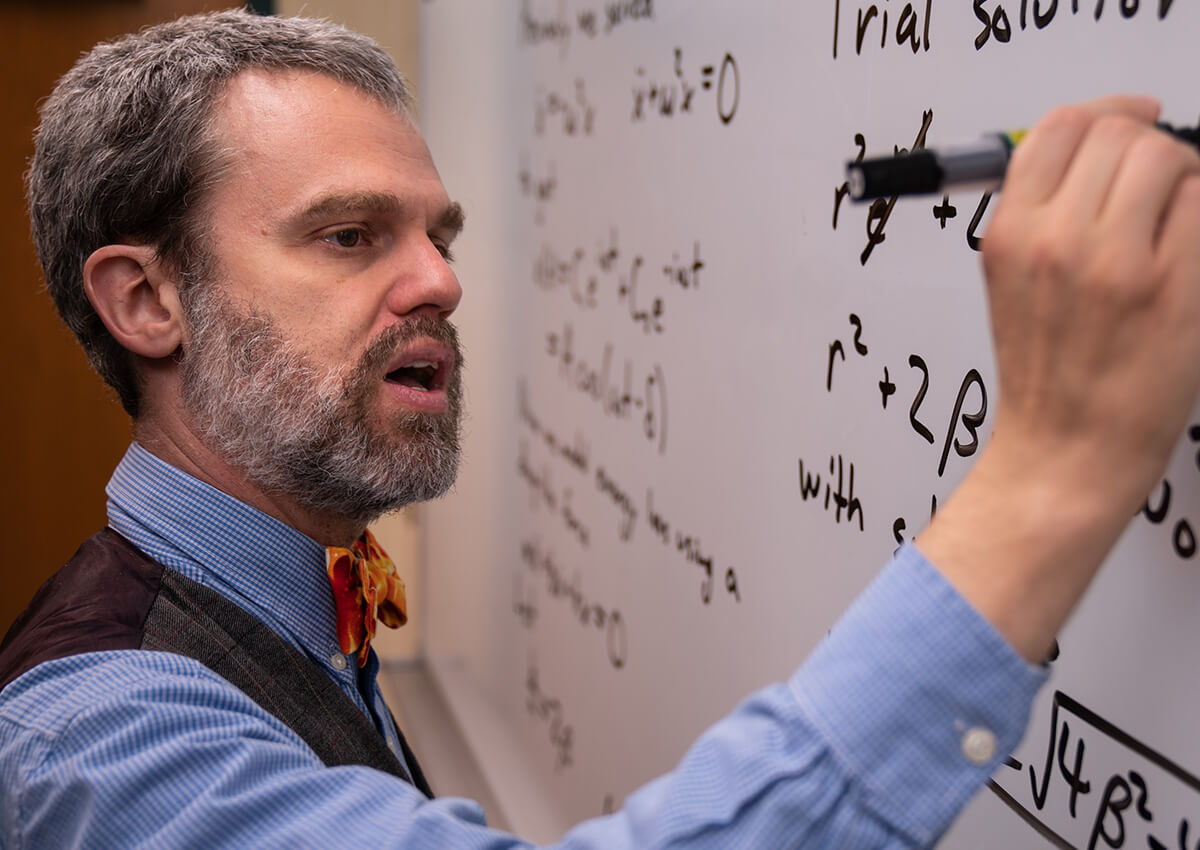My love of science began when I was in middle school, and spent many summer afternoons reading books full of science essays (along with a fair number of science fiction novels!) at the public library. My father had a degree in chemistry, and loaned me some of his old textbooks to read, giving me a solid background in college chemistry before I had even reached high school. I took some courses early, and had finished the first two years a chemistry degree before I even graduated. With the extra time available, I decided to add a physics major.
Despite being accepted in chemistry at prestigious graduate programs like Stanford and the University of Chicago, I decided I wanted to continue in physics instead, since I enjoyed the course work so much. The University of Colorado's campus at Boulder offered me a chance to do research that substantially overlapped with my chemistry interests in theoretical molecular spectroscopy, while still getting a doctoral degree in physics. I regard this combination as the best of both worlds, -- getting to do research in down-to-earth topics like the behavior of light interacting with molecules, while being immersed in rigorous study of the fundamental physical laws of the universe.
Since graduation, I've focused on becoming the best teacher possible and on improving my understanding of the best ways to clearly communicate topics in undergraduate physics. With a major in engineering physics, LeTourneau students will be well-equipped to transition into a variety of more applied fields, but you'll also be prepared to tackle graduate study in fundamental physics as well.
In my spare time, I love to read books to my two little daughters, Milli and Molly, and to expand -- and occasionally find opponents for playing -- my ever-growing collection of tabletop games and fantasy miniatures. I also enjoy running and swimming over at the Solheim Rec Center, or even outdoors during the three months when Texas weather actually becomes bearable (sorry, I'm a Michigan native!)
Education
- Ph.D., University of Colorado
- B.S., Calvin College
Courses Taught
- General Physics I and II
- University Physics I and II
- Advanced Mechanics
- Relativity and Quantum Mechanics
Experience
|
2011-Present |
Assistant Professor of Physics LeTourneau University |
|
2010 |
Lecturer, Department of Physics Gonzaga University |
|
2007-2010 |
Visiting Professor, Department of Physics Grand Valley State University |
|
2003-2007 |
Postdoctoral Fellow, Department of Chemistry Northwestern University |
|
1998-2003 |
Graduate Research Assistant University of Colorado |
|
1997-1998 |
Graduate Teaching Assistant, Department of Physics University of Colorado |
|
1994-1997 |
Student Research Assistant, Department of Physics Calvin College |
Honors
- Last Lecture Series, invited talk, November 2009.
- Professor of the Month, GVSU Interfraternity Council, April 2009.
- "Someone Who Really Makes A Difference At GVSU" nominee, 2008 & 2009.
- Mathematics Departmental Award for Outstanding Graduating Senior, Calvin College, 1997.
- INFORMS Award, Mathematical Contest in Modeling, 1997.
- John A. Bolt Memorial Scholarship, Chemistry, Calvin College, 1996-1997.
- John and Lillian Van Oosten Scholarship, Physics, Calvin College, 1995-1996.
- O.K. Bouwsma Memorial Award, Philosophy, Calvin College, 1994
Publications
- "Experimental verification of minima in excited long-range Rydberg states of Rb2"
C.H. Greene, E.L. Hamilton, H. Crowell, C. Vadla, and K. Niemax,
Phys. Rev. Lett. 97, 233002 (2006). - "Alignment enhancement by the combination of a short and a long laser pulse"
Mikael D. Poulsen et al.,
Phys. Rev. A 73, 033405 (2006). - "Nonadiabatic Alignment by Intense Pulses. Concepts, Theory, and Directions"
T. Seideman and E. Hamilton,
Ad. At. Mol. Opt. Phys. 52, 289 (2005). - "Nonadiabatic laser-induced alignment of iodobenzene molecules"
E. Peronne et al.,
Phys. Rev. A 70, 063410 (2004). - "Nonadiabatic alignment of asymmetric top molecules: Rotational revivals"
M.D. Poulsen et al.,
J. Chem. Phys. 121, 783-791 (2004). - "Competition among molecular fragmentation channels described with Siegert channel pseudostates,"
E.L. Hamilton and C.H. Greene,
Phys. Rev. Lett. 89, 263003 (2002). - "Shape-resonance-induced long-range molecular Rydberg states,"
E.L. Hamilton, C.H. Greene, and H.R. Sadeghpour,
J Phys. B 35, L199-L206 (2002). - "Quantum and semiclassical analysis of long-range Rydberg molecules,"
B.E. Granger, E.L. Hamilton, and C.H. Greene,
Phys. Rev. A 64, 042508 (2001). - "Calculation of a preconvolved HD photoionization spectrum using the rovibrational frame transformation,"
E.L. Hamilton, C.H. Greene, and J.A. Stephens,
Phys. Essays 13, 265-271 (2000). - "Numerical studies of one-photon near-threshold photodetachment,"
S.L. Haan, M. Dekker, E. Hamilton, and D. Streuker,
Laser Phys. 9, 190-200 (1999). - "A computational study of M-M multiple bonding in Ph2MMPh2n-, where M=B or Al, and n=0, 1, or 2,"
E.L. Hamilton, J.G. Pruis, R.L. DeKock, and K.J. Jalkanen,
Main Group Met. Chem. 21, 219-224 (1998). - "Collapsing dressed states and photoelectron spectra in near-threshold photodetachment,"
S.L. Haan, E. Hamilton, and B. Langdon,
Laser Phys. 7, 892-896 (1997). - "Pursuit-evasion game in the late Cretaceous,"
E.L. Hamilton, S.A. Menninga, D. Tong,
The UMAP Journal, 18, 213, (1997).
Professional Organizations and Activities
Member:
- American Physical Society, 2001-present.
- Division of AMO Physics, 2001-present.
- American Association of Physics Teachers, 2009.
- Council on Undergraduate Research, 2009-present.
Referee:
- Journal of Physics B, 2002-present.
- Journal of Physics A, 2006-present.
- Journal of Physics: Condensed Matter, 2006-present.
- New Journal of Physics, 2011.
- Journal of Chemical Physics, 2006.
